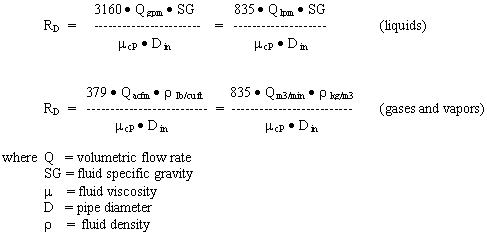|
||
E-Zine April 2008
Click here to review Part 1 Reynolds number is the dimensionless ratio of the inertial forces (that tend to move the fluid downstream) to the viscous forces (that tend to slow the fluid). This ratio gives an indication of the hydraulic nature of the fluid flow. Typically, fluid flows with similar Reynolds numbers exhibit similar hydraulic characteristics. The following equations can be used to calculate Reynolds number in pipes.
In general, vortex shedding and fluidic flowmeters operate linearly at high Reynolds numbers. When Reynolds number decreases below a certain value (depending upon flowmeter design and size), the flowmeter becomes nonlinear. Decreasing the Reynolds number further will cause oscillations to cease and the flowmeter will turn off. This creates the possibility of three distinct regions of operation that are dependent upon Reynolds number --- linear, nonlinear, and off. For vortex shedders, the linear operating region is typically above a Reynolds number of approximately 10,000 to 20,000, but could be higher in some designs and sizes. These flowmeters generally turn off below Reynolds numbers of 3000 to 10,000. The linear range of operation for fluidic flowmeters can extend to Reynolds numbers of approximately 500 or less. Note that the cause of the low Reynolds number could be one or more of many, such as a lower than expected flow rate, a composition change that increases viscosity, or a temperature change that increases viscosity. It is important to understand that fluid velocity and Reynolds number constraints are used to determine the conditions under which these flowmeters will operate, and when they will operate linearly. Both constraints must be satisfied for proper operation. For example, a vortex shedding flowmeter will not function in an application where Reynolds number is 1,000,000 when the fluid velocity is only 0.1 meter per second (0.3 feet per second) because its minimum velocity constraint is not met. Similarly, a vortex shedding flowmeter will not function at a velocity of 2 meters per second (6.5 feet per second) when Reynolds number is 100 because its minimum Reynolds number constraint is not met. Both velocity and Reynolds number constraints must be met for proper operation. There has been a trend to incorporate multiple process variable measurements into instruments. Generally, this has occurred where additional measurements are necessary for proper operation of the flowmeter, such as when the raw measurement must be compensated for fluid temperature in order to perform within specifications. However, even though purchasing multivariable instruments may be more expensive, this approach can reduce the number of piping penetrations and reduce installed cost as compared to purchasing and installing multiple devices. Multivariable instruments are becoming more available where users in a market segment will pay a premium. At least one vortex shedding flowmeter supplier has embedded a temperature measurement into the shedder to measure fluid temperature in the vortex shedding flowmeter. Some suppliers are embedding flow computers into their transmitters to infer mass flow and density for use in gas and steam flow applications. Excerpted from The Consumer Guide to Vortex Shedding and Fluidic Flowmeters ISSN 1538-5280 |
||


